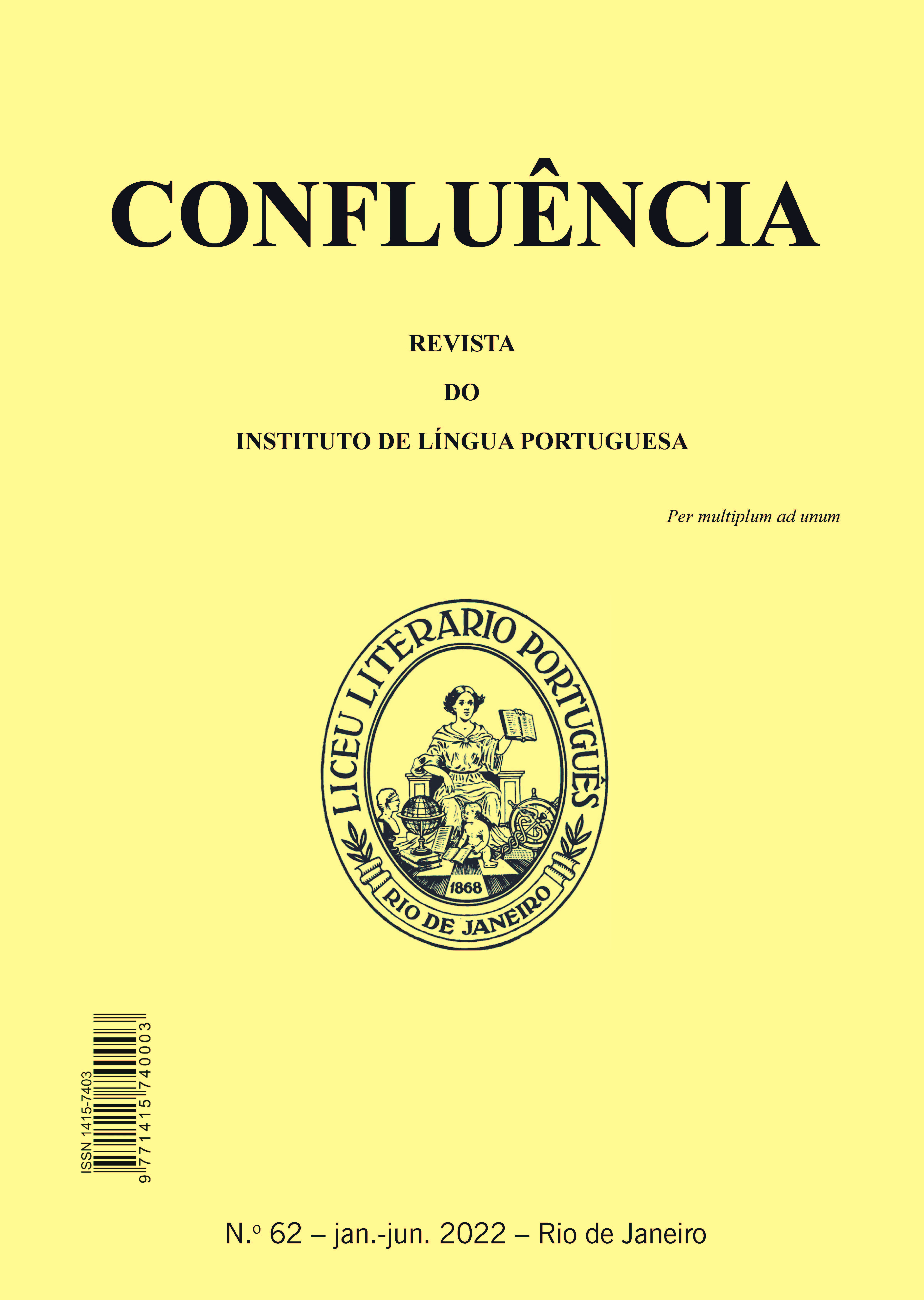Cohesive and semantic properties of the complex construction [com isso]connector in the light of cognitive-functional linguistics
DOI:
https://doi.org/10.18364/rc.2022n62.521Keywords:
The complex construction [com isso], Cohesive relations, Cognitive-Functional LinguisticsAbstract
[com isso]connector is a complex construction that acts in the articulation of clauses, periods and paragraphs. It has a double cohesive function, since it is a sequencing and referencing mechanism. On the one hand, the preposition com establishes a temporal, logical-semantic or discursive-argumentative relationship between different discursive units; on the other, the demonstrative pronoun isso e ncapsulates p receding p ortions o f t ext. I n a ddition, i t i s a polyfunctional construction – since it can act as a sequencer or a connector – and polysemic – since it can assume semantic values of time, consequence, conclusion and elaboration. The tokens are described qualitatively in the light of Cognitive-Functional Linguistics (cf. CUNHA et al., 2013; OLIVEIRA and ROSÁRIO, 2016, among other), in dialogue with studies of Systemic Functional Linguistics (HALLIDAY, 2004), Pragmatics (SWEETSER, 1990) and Text Linguistics (cf. KOCH, 2003; FÁVERO, 2004).
Downloads
References
ANDRADE, F. A. A. Conectores sequenciadores em artigos de opinião escritos por vestibulandos: uma questão de marcação linguística com implicações para o ensino. Dissertação (Mestrado). 112f. Centro de Ciências Humanas, Letras e Artes. Universidade Federal do Rio Grande do Norte, 2011.
BARRETO, E. A; FREITAG, M. Ko. Procedimentos discursivos na escrita de Itabaiana/SE: estratégias de sequenciação de informação. Sciencia Plena. v.5, n. 11, 2009, p. 01-11.
BERBER SARDINHA, A. P. Linguística de Corpus. Barueri: Manola, 2004.
BYBEE, J. Language, Usage and Cognition. New York: Cambrigde University Press, 2010.
CAPPELLE, B. Particle placement and the case for “allostructions”. In: DORIS CHÖNEFELD (ed.) Constructions all over: case studies and theoretical implications, Constructions. Special volume 1, 2006. Disponível em: http://www.constructions-online.de/articles/specvol1. Acesso em 04/03/2019.
CUNHA, M.A.F; BISPO, E. B; SILVA, J. R. Linguística Funcional Centrada no Uso: conceitos básicos e categorias analíticas. In: CEZARIO, M. M; CUNHA, M. A. F. (Orgs). Linguística centrada no uso: uma homenagem a Mário Martelotta. Rio de Janeiro: Mauad-Faperj, 2013, p. 13-39.
DIESSEL, H. The Grammar Network. How linguistic structure is shaped by language use. New York: Cambridge University Press, 2019.
DUCROT, O. Les mots du discours. Paris: Ed. de Minuit, 1980.
FÁVERO, L. L. Coesão e coerência textuais. São Paulo: Editora Ática, 2004.
HEINE, B; CLAUDI, U; HÜNNEMEYER, F. Grammaticalization: a conceptual framework. Chicago: University of Chicago Press, 1991.
HILPERT, M. Construction Grammar and its Application to English. Edimburgo: Edinburgh University Press, 2014.
KOCH, I. G. V. Argumentação e linguagem. São Paulo: Editora Cortez, 2002.
_____. A coesão textual. São Paulo: Contexto, 2003.
LACERDA, P. F. A. C. O papel do método misto na análise de processos de mudança em uma abordagem construcional: reflexões e propostas. Revista Linguística/Revista do Programa de Pós-Graduação em Linguística da Universidade Federal do Rio de Janeiro. Volume Especial, 2016, p. 83-101.
LOPES, M. G. Relações coesivas e semânticas da construção [por isso] à luz da LFCU. Anais do V Simpósio Internacional de Linguística Funcional. Goiás Velho: UEG, 2019, p. 45-58.
LOPES, M. G; MOURA, S. C. As construções conectoras [com isso] e [como se não bastasse (x)] na promoção da coesão híbrida: um estudo centrado no uso. Revista Soletras, n.41, 2021, p. 189-215.
MARQUES, N. B. N; PEZATTI, E. G. A relação conclusiva na língua portuguesa: funções resumo, conclusão e consequência. São Paulo: Editora UNESP, 2015.
MATTOSO CÂMARA Jr., J. História e Estrutura da Língua Portuguesa. Rio de Janeiro, Padrão, 1975.
OLIVEIRA, M. R; ROSÁRIO, I. C. Funcionalismo e abordagem construcional da gramática. Revista Alfa, São Paulo, n. 60, v. 2, 2016, p. 233-259.
HALLIDAY, M. A. K. An Introduction to Functional Grammar. 3rd. Edition. Londres: Hodder Arnold, 2004.
HASELOW, A. A processual view on grammar: Macrogrammar and the final field in spoken syntax. Language Sciences. 54, 2016, p. 77-101.
PEREK, F. Argument Structure in Usage-Based Construction Grammar. Amsterdam/Philadelphia: John Benjamins, 2015.
PLATÃO, F. S; FIORIN, J. L. Lições de texto: leitura e redação. São Paulo: Editora Ática, 2001.
SILVA, W. P. B. Conectores sequenciadores “e” e “aí” em contos e narrativas de experiência pessoal escritos por alunos de ensino fundamental: uma abordagem sociofuncionalista. Dissertação (Mestrado). 121f. Centro de Ciências Humanas, Letras e Artes. Universidade Federal do Rio Grande do Norte, 2013.
SWEETSER, E. From Etymology to Pragmatics. Metaphorical and Cultural Aspects of Semantic Structure. Peking: Peking University Press, 1990.
TANTUCCI, V. From Co-Actionality to Extended Intersubjectivity: Drawing on Language Change and Ontogenetic Development. Applied Linguistics. New York: Oxford University Press, 2018.
TRAUGOTT, E. C; TROUSDALE, G. Constructionalization and Constructional Changes. New York: Oxford University Press, 2013.
Downloads
Published
Issue
Section
License
Copyright (c) 2022 Monclar Guimarães Lopes, Simone Josefa da Silva

This work is licensed under a Creative Commons Attribution-NonCommercial 4.0 International License.
The author who publishes in this journal agrees to the following terms: The author maintains the copyright and grants the journal the right of first publication, with the work simultaneously licensed under the Creative Commons Attribution License that allows the sharing of the work with acknowledgment of the authorship and initial publication in this journal. The author is authorized to take additional contracts separately, for non-exclusive distribution of the version of the work published in this journal (eg publish in institutional repository or as a book chapter), with acknowledgment of authorship and initial publication in this journal. The author is allowed and encouraged to publish and distribute his work online (eg in institutional repositories or on their personal page) at any point before or during the editorial process, as this can generate productive changes, as well as increase the impact and citation of the published work.








